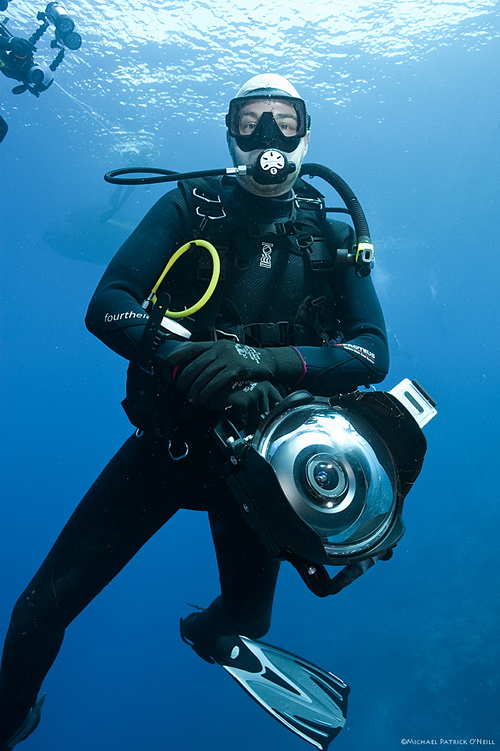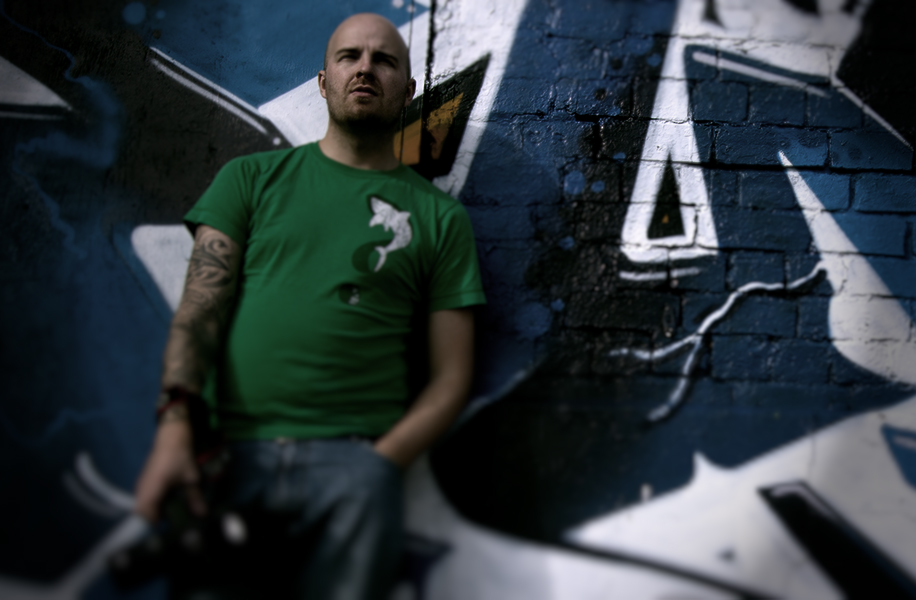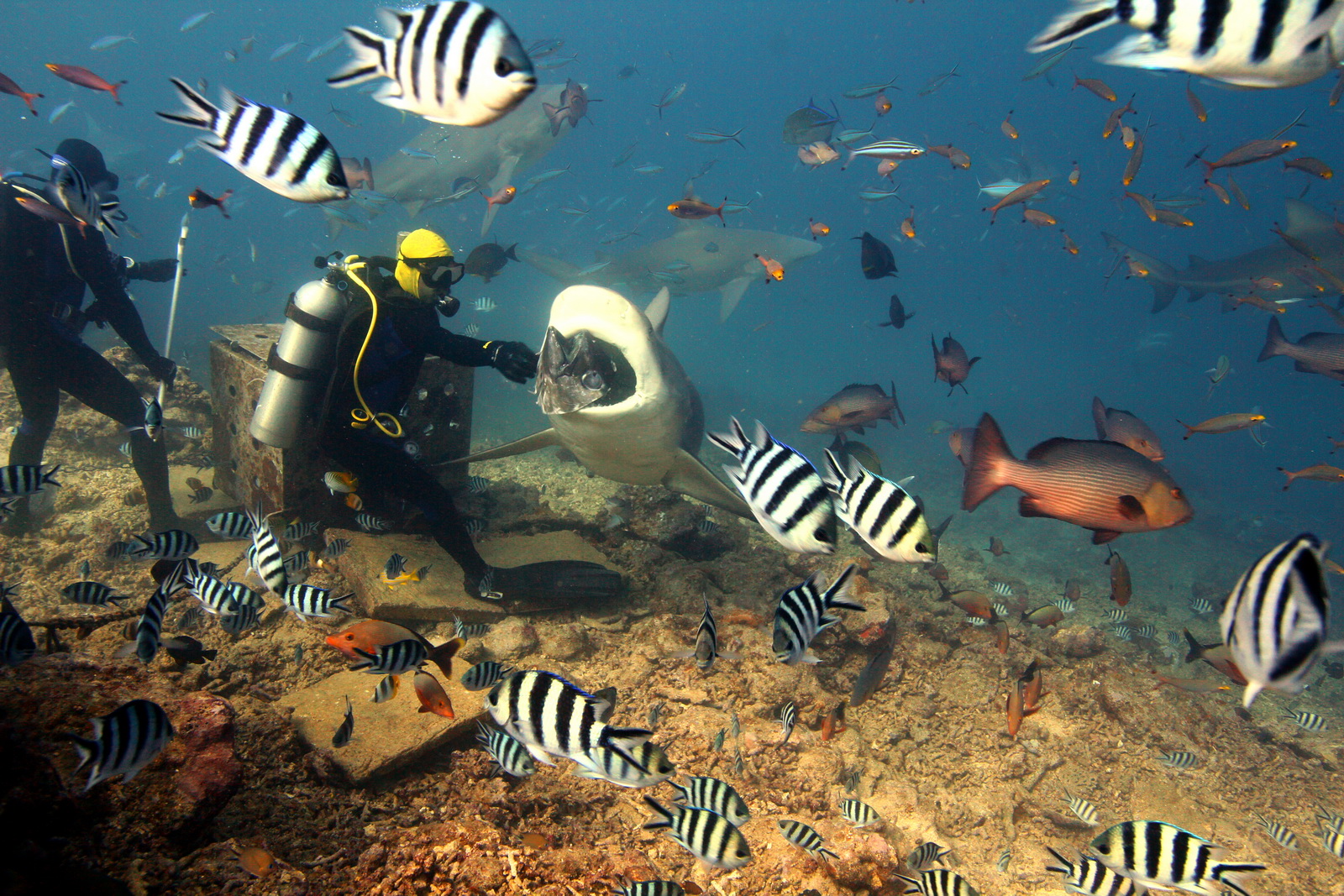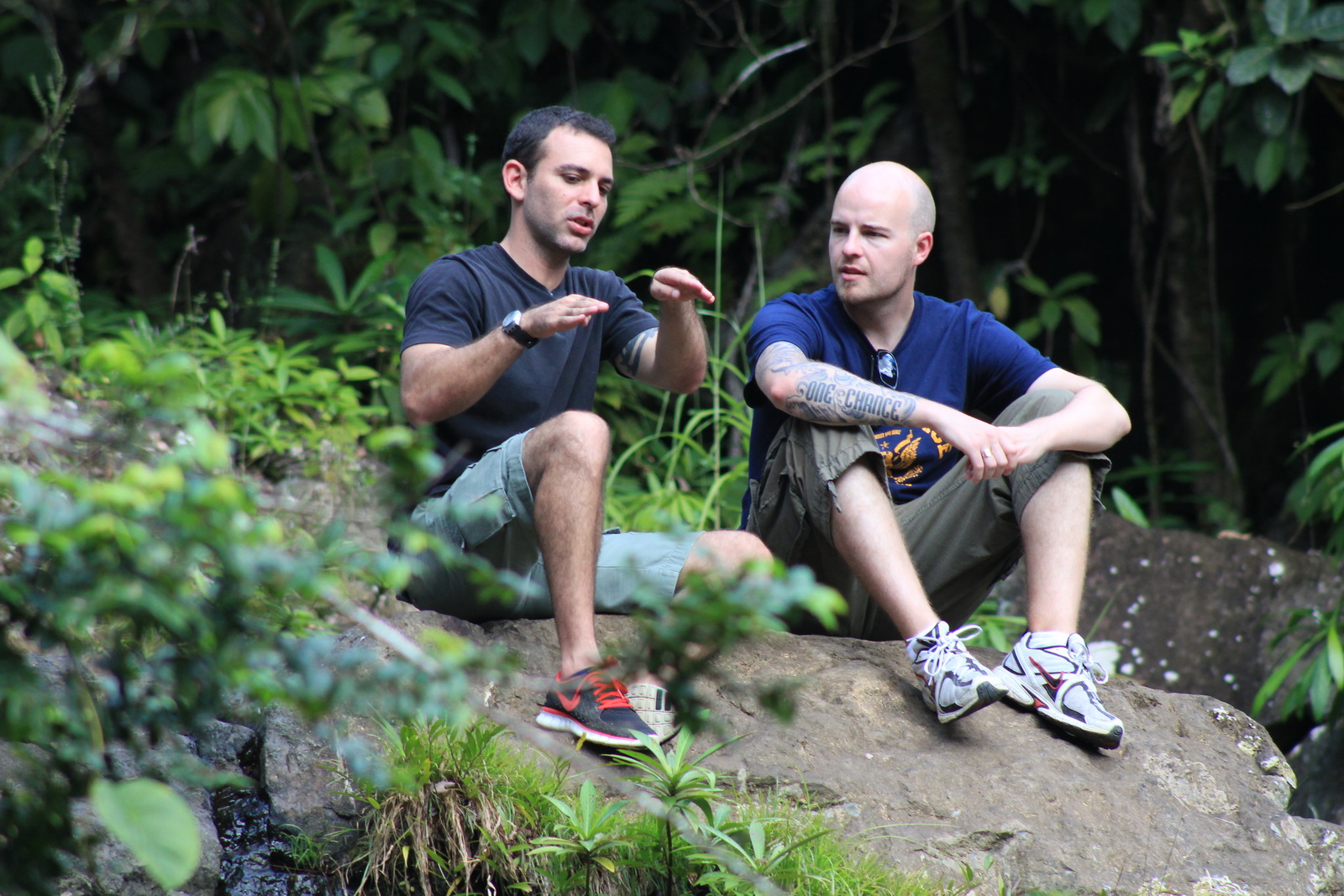One day, David Diley realized he couldn’t take any more. It was a Sunday in 2010, and Sundays back then meant only one thing: another week of work was looming. “It was the same every Sunday - I’d get this feeling of dread. I’d been working as a recruitment consultant for three years and in the final 12 months my sense of contentment just went into a downward spiral,” says the 35 year old Yorkshireman. He had to get out, but he couldn’t just leave without a plan. “So I figured the best plan would be to make a movie about sharks.”
For a man from a landlocked part of England’s industrial north, with no financial backing, whose prior film experience involved “shooting a couple of home videos of my band on a handicam,” this was a bold move. But Diley loves sharks. Really loves them. “My dad was a big naturalist and I think that started it...I remember we found a huge fish washed up on a beach and that ws the first time he told me about sharks. Then I saw Jaws and I was hooked!” If sharks were his number one passion, music was his second and Diley spent his first few years out of college touring with his heavy metal band. “I figured I’d be a rockstar first and then retire and follow my passion for sharks,” he laughs. But by 2007, the band had split, Diley was out of cash and a recession was looming. There wasn’t much choice but to get a ‘proper’ job.
Lucky for him, when he left the rat race, serendipity lent a helping hand. “I was always into sharks and shark conservation - I started writing articles for fun around the age of 12,” he explains. In 2008 he wrote a piece on the controversial issue of shark feeding for Diver magazine. “I didn’t think much about it at the time, but six months later I discovered the story had been picked up by all these prominent dive blogs.” One such blog was by a guy called Mike Neumann, who ran a dive operation at a site called Shark Reef in Fiji that touted itself as “The Best Shark Dive in the World.”
“I’d read a paragraph about Shark Reef years ago, so I contacted him and said that one day I wanted to make a film and if it happened, would he take me diving there. He wrote back and said yes, he’d give me a discount. And that’s how it began.”
In the late nineties, Shark Reef was in a parlous state. Situated between Fiji’s main island Viti Levu and the Beqa lagoon to the south, it had been decimated by industrial overfishing. There was nothing left but a waseteland of broken coral. One day a diver showed up in search of a shark feeding site. He approached the villagers that owned the reef (based on ancient systems of ancestral marine tenure common in the Pacific) and told the chief he reckoned he could attract sharks there - and more importantly, tourists.
Over the years, shark numbers blossomed and with them the damaged corals, as the peak predators caused a so-called positive trophic cascade that enlivened the ecosystem, causing reef species further down the food chain to return. Today, hundreds of species of fish and coral thrive there - but it’s the sharks that the people come to see.
Eight shark species are common to these waters, including hammerheads, sickle fin lemon sharks and tawny nurse sharks, alongside the more familiar white and black tip reef sharks. None of them compare to the bulls though. “There’s no doubt that those guys are the main event,” says Diley. There’s nowhere else that you can see 100 of the biggest bull sharks on the planet on a single dive.”
Diley realised this was the story he was looking for - here was an iconic marine reserve centred on sharks that seemed to be flourishing precisely because it employed shark feeding techniques - long an incendiary subject among marine conservationists. “Mike [Neumann] was an ex banker who wanted to get into shark conservation and this was the perfect place,” says Diley. “He saw an opportunity to protect sharks by creating a long term business plan that provided money to the village and to the economy as a whole.”
By setting up the feed, Neumann created a massive shark aggregation that drew the world’s leading underwater filmmakers, including two icons of the shark world - Ron and Valerie Taylor. “They got this incredible footage that was seen around the world and suddenly Fiji was on the shark tourism map.” In 2004 the Shark Reef marine reserve was established and the site is now a growing hub of research into shark migration patterns. Diley points out that aggregating sharks in protected areas doesn’t affect fishing communities, or the shark’s natural behaviour. “There’s this myth that sharks stop being migratory if you create an aggregation. But in Fiji, they turn up for two or three days, never more than around two weeks. And out of 100, only around 10 will actually feed.”
Lucky for him, when he left the rat race, serendipity lent a helping hand. “I was always into sharks and shark conservation - I started writing articles for fun around the age of 12,” he explains. In 2008 he wrote a piece on the controversial issue of shark feeding for Diver magazine. “I didn’t think much about it at the time, but six months later I discovered the story had been picked up by all these prominent dive blogs.” One such blog was by a guy called Mike Neumann, who ran a dive operation at a site called Shark Reef in Fiji that touted itself as “The Best Shark Dive in the World.”
“I’d read a paragraph about Shark Reef years ago, so I contacted him and said that one day I wanted to make a film and if it happened, would he take me diving there. He wrote back and said yes, he’d give me a discount. And that’s how it began.”
"Of Shark and Man" Teaser Trailer 3 (Letterboxed Version) from Scarlet View Media on Vimeo.
In the late nineties, Shark Reef was in a parlous state. Situated between Fiji’s main island Viti Levu and the Beqa lagoon to the south, it had been decimated by industrial overfishing. There was nothing left but a waseteland of broken coral. One day a diver showed up in search of a shark feeding site. He approached the villagers that owned the reef (based on ancient systems of ancestral marine tenure common in the Pacific) and told the chief he reckoned he could attract sharks there - and more importantly, tourists.
Over the years, shark numbers blossomed and with them the damaged corals, as the peak predators caused a so-called positive trophic cascade that enlivened the ecosystem, causing reef species further down the food chain to return. Today, hundreds of species of fish and coral thrive there - but it’s the sharks that the people come to see.
Eight shark species are common to these waters, including hammerheads, sickle fin lemon sharks and tawny nurse sharks, alongside the more familiar white and black tip reef sharks. None of them compare to the bulls though. “There’s no doubt that those guys are the main event,” says Diley. There’s nowhere else that you can see 100 of the biggest bull sharks on the planet on a single dive.”
Diley realised this was the story he was looking for - here was an iconic marine reserve centred on sharks that seemed to be flourishing precisely because it employed shark feeding techniques - long an incendiary subject among marine conservationists. “Mike [Neumann] was an ex banker who wanted to get into shark conservation and this was the perfect place,” says Diley. “He saw an opportunity to protect sharks by creating a long term business plan that provided money to the village and to the economy as a whole.”
By setting up the feed, Neumann created a massive shark aggregation that drew the world’s leading underwater filmmakers, including two icons of the shark world - Ron and Valerie Taylor. “They got this incredible footage that was seen around the world and suddenly Fiji was on the shark tourism map.” In 2004 the Shark Reef marine reserve was established and the site is now a growing hub of research into shark migration patterns. Diley points out that aggregating sharks in protected areas doesn’t affect fishing communities, or the shark’s natural behaviour. “There’s this myth that sharks stop being migratory if you create an aggregation. But in Fiji, they turn up for two or three days, never more than around two weeks. And out of 100, only around 10 will actually feed.”
A great story then, but Diley was 10,000 miles away in Leeds. He had a promise of support from Neumann but not much else. Whenever doubts crept in though, something happened to keep him on track. “I randomly met the founder of [surf brand] Fourth Element and he was really encouraging, saying he could maybe help with sponsorship down the line. And Paul Rose, who’s an explorer and presenter who does loads of stuff for the BBC, he was egging me on too, saying anything in the world is possible!”
The real breakthrough came when he met Jane West and Martin Harlow of Tourism Fiji at a dive show, in October 2010, three months after leaving his job. “I’d gone to all these stalls trying to drum up interest and at the end of the day when I was about to give up, I stumbled on their stall. We talked and they were really into the story and the whole conservation angle. They saw the benefit for Fiji. I sent them a proposal and it snowballed from there.”
Almost a year after he’d left his job, Diley was flying to Fiji for a planned four week shoot at Shark Reef. He was working with a skeleton crew which included Hugh Fairs, an underwater cameraman with fifteen years film and TV experience. “It was tough. Two dives every day, interviews in between, a beer at sunset, dinner and then by 8pm I’d be logging and backing up footage. A pretty crazy way to shoot a feature!”
The dives themselves were intense. The tourists feed the sharks from behind a wall and follow strict protocols, but Diley had to get closer. “I started out just on the other side of the mesh with a bodyguard who had an aluminium pole ready to hit any aggressive sharks. I still had to knock some aside with my camera.” Over the course of the month, he moved further into the deep and by the end, he was witnessing feeding frenzies close up. “The staff put these tuna heads in a coral hole and suddenly you’ve go these 3.5 metre sharks going crazy all around you. It was incredible!”
Three years on and Diley is on the cusp of releasing his film Of Shark & Man. He plans to take it to film festivals with a view to getting international distribution, something that he’ll need to find funds to do. The film is as much about him - an ordinary guy trying to do extraordinary things - as it is about Shark Reef, shark feeding and conservation. “Everything now has to be done quickly, wrapped in 47 minutes to leave room for commercials,” he says. “This is a love letter to people who care about the craft of film making in relation to sharks, it harks back to the films of the seventies and eighties, like Blue Water White Death. It’s a personal journey, but it’s also a story that hasn’t been told.”
From the Office to the Ocean: Of Shark & Man is due for release in early 2015
www.officetoocean.com
The real breakthrough came when he met Jane West and Martin Harlow of Tourism Fiji at a dive show, in October 2010, three months after leaving his job. “I’d gone to all these stalls trying to drum up interest and at the end of the day when I was about to give up, I stumbled on their stall. We talked and they were really into the story and the whole conservation angle. They saw the benefit for Fiji. I sent them a proposal and it snowballed from there.”
Almost a year after he’d left his job, Diley was flying to Fiji for a planned four week shoot at Shark Reef. He was working with a skeleton crew which included Hugh Fairs, an underwater cameraman with fifteen years film and TV experience. “It was tough. Two dives every day, interviews in between, a beer at sunset, dinner and then by 8pm I’d be logging and backing up footage. A pretty crazy way to shoot a feature!”
The dives themselves were intense. The tourists feed the sharks from behind a wall and follow strict protocols, but Diley had to get closer. “I started out just on the other side of the mesh with a bodyguard who had an aluminium pole ready to hit any aggressive sharks. I still had to knock some aside with my camera.” Over the course of the month, he moved further into the deep and by the end, he was witnessing feeding frenzies close up. “The staff put these tuna heads in a coral hole and suddenly you’ve go these 3.5 metre sharks going crazy all around you. It was incredible!”
Three years on and Diley is on the cusp of releasing his film Of Shark & Man. He plans to take it to film festivals with a view to getting international distribution, something that he’ll need to find funds to do. The film is as much about him - an ordinary guy trying to do extraordinary things - as it is about Shark Reef, shark feeding and conservation. “Everything now has to be done quickly, wrapped in 47 minutes to leave room for commercials,” he says. “This is a love letter to people who care about the craft of film making in relation to sharks, it harks back to the films of the seventies and eighties, like Blue Water White Death. It’s a personal journey, but it’s also a story that hasn’t been told.”
From the Office to the Ocean: Of Shark & Man is due for release in early 2015
www.officetoocean.com










